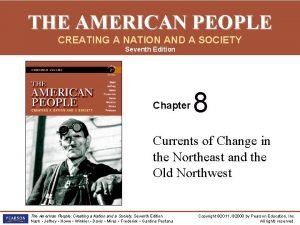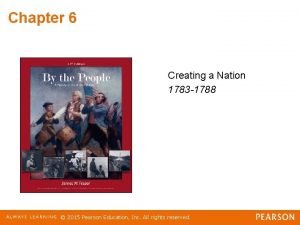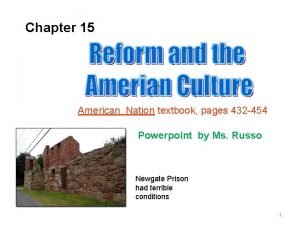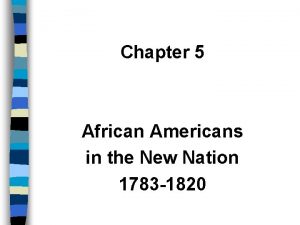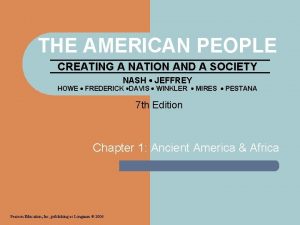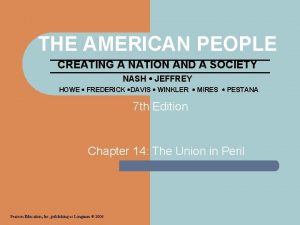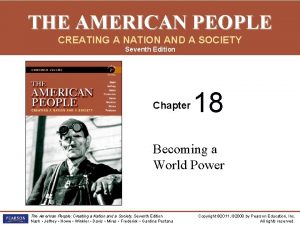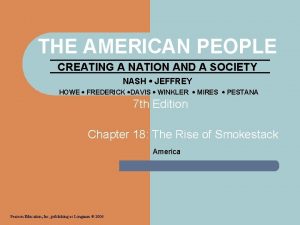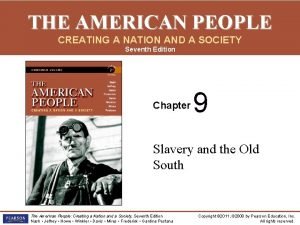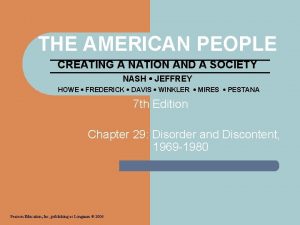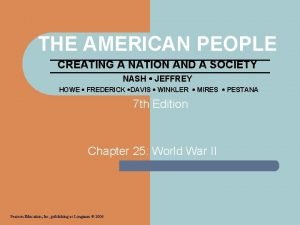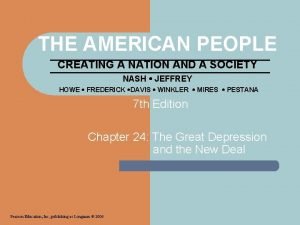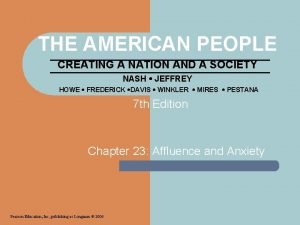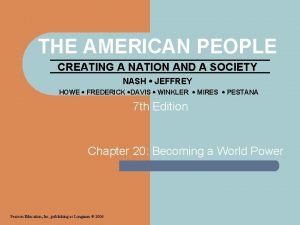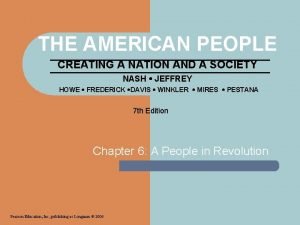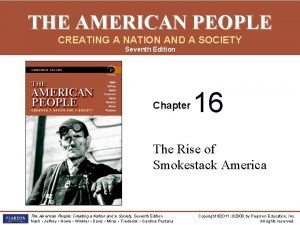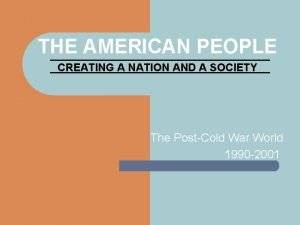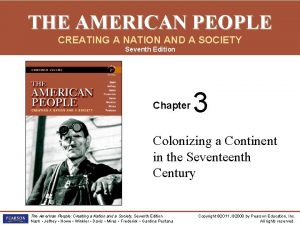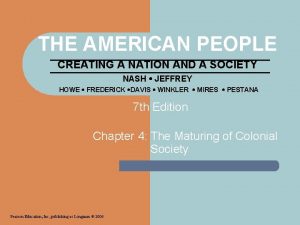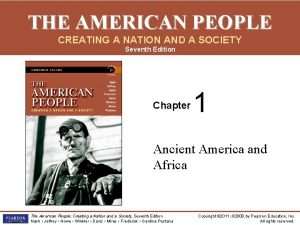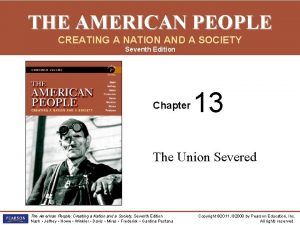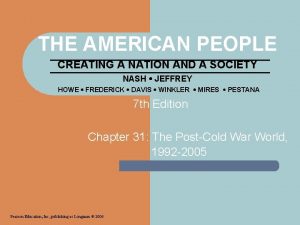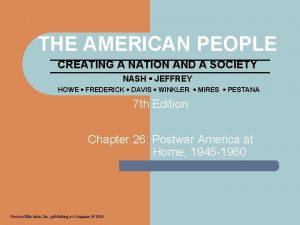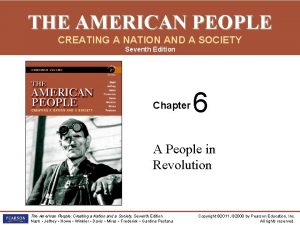THE AMERICAN PEOPLE CREATING A NATION AND A


















































- Slides: 50

THE AMERICAN PEOPLE CREATING A NATION AND A SOCIETY NASH JEFFREY HOWE FREDERICK DAVIS WINKLER MIRES PESTANA 7 th Edition Chapter 10: Economic Transformation In the Northeast and the Old Northwest Pearson Education, Inc, publishing as Longman © 2006

ECONOMIC GROWTH l Between 1820 and 1860, the American economy entered a new and more complex phase as it shifted from reliance on agriculture to an industrial and technological future – l Real per capita output grew an average of 2% annually between 1820 and 1840 and slightly less between 1840 and 1860 Periods of boom (1822 -1834, mid-1840 s-1850 s) alternated with periods of bust (1816 -1821, 18371843) – – A third of working-class Americans lost their jobs in depression years Problems in one area tended to affect another

THE TRANSATLANTIC CONTEXT FOR GROWTH l Economic growth in America was linked and influenced by a host of events elsewhere in the world, particularly in England – – The British Industrial Revolution spurred technical innovations that had far-reaching implications By 1850, Britain was the most powerful country in the world and its citizens the richest

FACTORS FUELING ECONOMIC DEVELOPMENT l l l The abundant natural resources of the United States Increased labor pools and consumers, due to immigration from Europe Improved modes of transportation encouraged economic and geographic expansion – – 1820 s & 1830 s: canal building projects, spurred by 363 mile Erie Canal At the same time, railroad construction was supported since railroads could operate year round and be built almost anywhere so that by 1850 s there was more than 30, 000 miles of track


FACTORS FUELING ECONOMIC DEVELOPMENT l Canals and railroads provided farmers, merchants and manufacturers with cheap and reliable access to distant markets and goods and encouraged Americans to settle the frontier and cultivate virgin land – – Fostered technological innovations that fostered production Tied Northwest and East together leading to shared political outlooks Railroads determined settlement patterns and city survival and drastically reduced travel times Stimulated agricultural expansion and regional specialization leading to cheaper food for workers and increased spending income for farmers



CAPITAL AND GOVERNMENT SUPPORT l Between 1790 and 1861, more than $500 million in foreign capital, was in vested in state bonds, transportation, and land, helping to finance one-third of canal construction and one-quarter of railroad bonds – – – American mercantile capital also fueled growth Local and state governments passed laws of incorporation, awarded tax breaks or monopolistic control, underwrote bonds, and provided loans The national government cooperated with states on some internal improvements while federal tariff policy shielded American products and the Second Bank of the United States provided financial stability

CAPITAL AND GOVERNMENT SUPPORT l Law promoted aggressive economic growth – – l Palmer v. Mulligan (1805) laid down principle that property ownership included the right to develop property for business purposes Land was increasingly defined as a productive asset for exploitation Investors and business operators wanted to increase predictability in the conduct of business – Led to rapid development in contract law

A NEW MENTALITY l l The entrepreneurial outlook, the “universal desire, ” encouraged investment, new business and agricultural ventures and land speculation Americans were mechanically minded and prided themselves on developing efficient tools and machines – l Cut labor costs and increased efficiency The rapid spreads of literacy and education after 1800 spurred innovation and discovery, leading to increased productivity – – – By 1840, most whites were literate and public schools were educating 38. 4% of white children between 5 and 19 Under the direction of Horace Mann, reform of state education for white children ballooned in 1837 Prominent industrialists were convinced that education produced reliable workers who could handle complex machinery without undue supervision


AMBIVALENCE TOWARD CHANGE l l Americans also believed in social value of education, expecting it to mold student character and promote “virtuous habits” and “rational self-governing” behavior Americans both welcomed economic progress and feared its results – – l Concerned that civilization might disintegrate as people moved far away from birth and familiar institutions Others worried rapid change would undermine the American family Authors took advantage of publishing revolution to pour out a variety of materials on how to get ahead, all of which depended on good character and hard work, diligence, temperance, punctuality and thrift

THE ADVANCE OF INDUSTRIALIZATION l l Based on the British model, the growth of industrialization in America fueled enormous economic growth and changes in other aspects of life in the years before the Civil War Factory production moved away from decentralized system of artisan or family production – – Some work was “put out” while other was moved into central locations, entangling rural families in the market economy and effecting their relationship with one another Piecework provided extra cash and some independence

THE ADVANCE OF INDUSTRIALIZATION l Manufacturers moved to consolidate all the steps of production under one roof and moved from hand labor to power-driven machinery – – – l British immigrants were used for their practical experience. Volume of goods rose and prices dropped dramatically Transportation improvements encouraged the reorganization of the production process and the use of machinery Between 1820 and 1860 textile manufacturing became the country’s leading industry – Early mechanization of cloth production supplemented home manufacture

THE ADVANCE OF INDUSTRIALIZATION l The mill at Waltham, Massachusetts, was capitalized at $300, 000 and used a new power loom invented by Francis Cabot Lowell and Paul Moody – – l l l All steps of cotton production were brought under one roof making cloth production cheaper and more profitable Constant innovation improved production and profits New England mills followed Lowell system but mills in Mid-Atlantic states were more varied Textile manufacturing supplanted home production of cloth New England became a manufacturing center for things beyond cloth with 71% of all manufacturing workers living there by 1860


ENVIRONMENTAL CONSEQUENCES l The impact of the swift economic growth of America had significant environmental repercussions – l l Insatiable demands for wood as fuel and building material destroyed forests and promoted soil erosion A later shift to coal blanketed the larger cities in pollution Dams and canals supporting industrial activity contributed to soil erosion and, combined with discharged mineral substances, were destructive to fish populations

EARLY MANUFACTURING l l Manufacturing led to the production of more goods at a lower cost Before the nineteenth century, cost of reading material was so high, literate families of moderate means often had little more than a Bible and an almanac – – l Between 1830 and 1850, a printing and publishing revolution led to the quintupling of the book market by 1850 The presence of inexpensive reading material encouraged literacy as well as literary production and deeply impacted people’s stock of information, values, tastes, and use of leisure time The manufacture of inexpensive timepieces in the 1830 s encouraged a more disciplined use of time and imposed a new rhythm in many workplaces

A NEW ENGLAND TEXTILE TOWN l Lowell, Massachusetts, demonstrates the importance of women in the early stages of industrialization – – l Planned and built in the 1820 s with 17, 000 inhabitants by 1836 Hired women who would work only until marriage Cincinnati, Ohio, shows that industrialization was often an uneven and complex process

WORKING AND LIVING IN A MILL TOWN l In 1830 more than 63% of Lowell’s population was female and most were between the ages of 15 and 29 – – l Had been deprived of traditional productive role by decline of home manufactures Offered an opportunity for economic independence, better wages than domestic service and an interesting environment Millwork was regimented and exhausting, 12 hours a day, six days a week – Required women to adapt to new work and living situations

FEMALE RESPONSES TO WORK l All female workers had limited job mobility and a top earner could receive 40% more in wages than a newcomer but never as much a a male worker who could earn 200% more than men at the bottom – – l Women did protest against being turned into wage workers especially after a 15% wage cut in 1834 Sought to link protests to the Revolution and revolutionary rhetoric that once held only political meaning took on economic overtones During the 1830 s, wage cuts, long hours, increased workloads and production speedups constantly threatened “wage slavery”

THE CHANGING CHARACTER OF THE WORKFORCE l l l The short term of female millworkers prevented permanent labor organizations Millowners replaced female laborers with new immigrants who came in in 1840 s and 1850 s so that by 1860 Irish laborers composed nearly half the workforce More than 2. 8 million migrants came to the United States in the 1850 s – – – Resulted from Europe’s population explosion and the new farming and industrial practices that undermined or ended traditional means of livelihood Irish, the largest group, came as a result of famine The second largest group, Germans, more often arrived with sufficient resources to go west and buy land


THE CHANGING CHARACTER OF THE WORKFORCE l l The arrival of so many non-British newcomers made American society more diverse and the fact many Irish and German immigrants were Catholic created religious tensions The arrival of the Irish undermined any solidarity in the mills and undercut the ability of Yankee women to protest changing conditions – – Irish women and Yankee women had little in common. More Irish men undercut female solidarity Segregated living conditions further undermined worker unity. As Yankee women left the mills, mill owners stopped paternalistic practices

FACTORIES ON THE FRONTIER l By 1840, Cincinnati was the country’s third-largest industrial center with a variety of industries in different stages of development – – – l As a result there was no typical work experience in the city where small or medium shops shared space with factories of more than 100 In the short run, machines did the rough work for artisans; only later did machines start to replace them Unskilled factory workers received low pay and had little job security Cincinnati’s large black community was so economically marginal, mot black women labored as washerwomen, cooks or maids – Many white women were “outworkers” for the city’s growing ready-to -wear clothing industry, which allowed them to work at home and maintain social norms while still earning necessary income

FACTORIES ON THE FRONTIER l Working conditions were terrible for outworkers and the marketing of sewing machines in the 1850 s only contributed to worsening conditions and lower pay – l Industrial conditions had produced a new kind of worker with only his labor to sell – – – l Increased pool of potential workers and the volume of work expected by bosses and made work more monotonous Workers saw as loss of independence Also resented masters’ attempts to control their lives. Workers’ wages rose more slowly than the costs of food and housing Meanwhile rich were getting richer so that by 1860 the top 10% owned two-thirds of the wealth while the bottom half only owned 2. 4%

FACTORIES ON THE FRONTIER l In the decades before the Civil War, workers formed unions, turned out for fair wages, and rallied in favor of the ten-hour day – – Cloaked protests in the rhetoric of the Revolution Only in 1850 s, though, did workers begin to see owners as a distinct class of parasitic “nonproducers” Depressions and bad times harmed labor organizations and their gains Ethnic, cultural, and religious diversity along with different work experiences prevented Cincinnati workers from readily uniting


URBAN LIFE l In 1820, 9% of Americans lived in cities and by 1860 the number had risen to 20% – – Growth occurred in both older cities and newer cities It was most dramatic in the East with more than one-third of the people in the Northeast living in urban areas compared to 14% of westerners and 7% of southerners

THE PROCESS OF URBANIZATION l Three types of cities emerged—commercial centers, mill towns, transportation hubs – – – l Until 1840, most of people crowding into cities came from the American countryside – l Commercial seaports expanded steadily and developed diversified manufacturing to supplement older functions with New York replacing Philadelphia as the country’s largest and most important city Water power access led to rise of mill towns Transportation hubs arose between 1820 and 1840 west of the Appalachian Mountains After that date, increasing numbers of immigrants arrived Cities were crowded, noisy, dirty and lacked most basic services

CLASS STRUCTURE IN THE CITIES l l Dramatic differenced in the quality of urban life reflected social fluidity and growing inequality Americans believed capitalists deserved the profits from the economic expansion of the country – l In Philadelphia, while growing overall wealth prevented mass suffering, the gap between the rich and poor got ever larger and class lines hardened Between 1820 and 1860 a new working and middle class took shape as factory production produced previous modes of production – – – Ten to 15% of Philadelphians improved their occupations and places of residence each decade before the Civil War Membership in middle class meant having a nonmanual occupation Downward mobility also increased and those living in poverty in increased from 17 to 24% of unskilled wage earners.


THE URBAN WORKING CLASS l Housing patters reflected social and economic divisions – – l Poorest people rented and moved often which prevented formation of close-knit neighborhoods Substantial houses on main street concealed worst urban housing Changing conditions meant that men, even when employed, could not be assured of supporting their families and often children and wives also had to work – Resulted in stresses in family relations

MIDDLE-CLASS LIFE AND IDEALS l The new middle class benefited from the economic growth in antebellum America – l Lived in pleasantly furnished houses, enjoying more peace, privacy and comfort than the less affluent Acceptance of certain norms and values identified a person as middle class – – Genteel behavior and etiquette, appropriate clothes and conversation, an elegantly furnished parlor for entertaining New gender roles also shaped middle class life as men increasingly involved themselves in the money economy while women occupied an increasingly “nonproductive” domestic sphere


MIDDLE-CLASS LIFE AND IDEALS l Men were charged with financial support while women were in charge of maintaining the home – l Women were given more elevated responsibilities as moral and cultural guardians of their own families and of society as a whole – – – l Sometimes it was difficult achieving new standards of cleanliness, order and beauty in the home Were considered innately pious, virtuous, unselfish and modest Were seen as preserving important values in a time of change and helping husbands resist temptations View of domesticity prompted women to take on activities in the outside world Ideals proposed by separate spheres were more flexible than they seem

MIDDLE-CLASS LIFE AND IDEALS l New notion of childhood also emerged, at least for middle-class children who no longer had to contribute to the family economics – – – l l Childhood was seen as separate stage of life Mothers were supposed to teach appropriate values through affection rather than punishment Children’s fiction also socialized children Publishing industry spread new ideas about family roles New notions of family life requiring more attention per child supported widespread use of contraception

MOUNTING URBAN TENSIONS l Social tensions as a result of class distinctions and wealth inequities led to dramatic increases in urban violence in the years before the Civil War – – – Violence sometimes lasted for days because large American cities were slow to establish a professional police force relying instead on volunteer constables Economic rivalry combined with race and ethnic issues often contributed to riots as did distress caused by undermining of small-scale mode of production Urban expansion also contributed to violence Character of free black community, especially if large and visible, could contribute to confrontation The rise of Catholic immigrants could also lead to social tensions that resulted in violence

THE BLACK UNDERCLASS l In the sixty years before the Civil War, the number of free blacks in America rose dramatically – l l l Although small elites emerged, most blacks did not enjoy the rewards of economic expansion and industrial progress Northern whites, like southerners, believed in black inferiority and depravity and feared black competition Blacks did not have equal rights and citizenship or economic opportunities – – – l Most of these free blacks lived in the northeastern cities although Baltimore had the largest population and New Orleans also had a sizeable one By 1840, 93% of northern black population could not vote Blacks could not testify against whites or serve on juries in five northern states and suffered other civil limitations Educational opportunities for free blacks were minimal Western states were equally inhospitable to blacks

RURAL COMMUNITIES l l Between 1830 and 1860 the percentage of American workers in farming fell from 71 to 53 though agriculture remained the economic activity Agriculture changed in antebellum period as new tracts of land came under cultivation in the West and improved transportation pulled rural Americans into the orbit of the wider world – l Goods went to regional and national markets and manufactured products flowed into the countryside Commercial farming encouraged different ways of thinking and acting and lessened isolation

FARMING IN THE EAST l As marginal land in New England became unproductive, farmers, after 1830, moved west – – l Improved farming methods contributed to increased agricultural output – l Farmers who did not move west had to adopt new farming techniques and specialize As adopted new crops, farmers began to regard farming as a scientific endeavor using manure as fertilizer and rotating their crops, for instance Experimentation and exchange of information led to development of thousands of special varieties of plants Cash transactions replaced barter and wealth inequality increased throughout rural northeast

FRONTIER FAMILIES l l After the War of 1812, movement to the Old Northwest began in earnest Changes in federal land policy, which reduced prices and the minimum acreage a settler had to buy, helped stimulate migration – l l Eastern capital contributed to speculative buying Internal improvement schemes after 1830 contributed to new settlement patterns and tied Old Northwest to East as wheat for East replaced corn and hog for the South Old Northwest passed rapidly through the frontier stage but farming families still faced severe challenges – – Western farms were small because there were limits to what a family with hand tools could manage Starting a farm cost money


OPPORTUNITIES IN THE OLD NORTHWEST l Farmers could begin without cash by borrowing money, renting land or working as hired labor – – – l Tenants who furnished seeds and animals could keep about one-third After several years most could earn enough to buy their own land. While there was no class of propertyless wage earners there were social inequalities with the wealthiest 8% owning half the wealth by 1860 Commercial farming brought new patterns of family life and many farm families had money to spend on new goods

AGRICULTURE AND THE ENVIRONMENT l When eastern farmers joined the market economy their decisions affected the land. – – l Forests and wildlife disappeared Use of fertilizers resulted in the depletion of land elsewhere When farmers moved into the Old Northwest, they used steel plows resulting in deep plowing and intensive cultivation of large cash crops – Robbed soil of needed minerals and contributed to forest destruction with needs to build houses


DISCOVERING U. S. HISTORY ONLINE Whole Cloth: Discovering Science and Technology Through American History http: //invention. smithsonian. org/centerpieces/whole_cloth/ l 19 th-Century Scientific American Online http: //www. history. rochester. edu/Scientific_American/ l Jacksonian Medicine http: //www. connerprairie. org/History. Online/jmed. html l Penn 1830: A Virtual Tour http: //www. archives. upenn. edu/histy/features/1830/ l A Brief History of Central Banking in the United States http: //odur. let. rug. nl/~usa/E/usbank/bankxx. htm l

DISCOVERING U. S. HISTORY ONLINE The Erie Canal www. syracuse. com/features/eriecanal l Inland Navigation: Connecting the New Republic, 1790 -1840 http: //xroads. virginia. edu/~HYPER/DETOC/transport/fro nt. html l Lowell National Historic Park http: //www. nps. gov/lowe/2002/home. htm l 19 th-Century Schoolbooks http: //digital. library. pitt. edu/nietz/ l

DISCOVERING U. S. HISTORY ONLINE The Gentleman’s Page: A Practical Guide for the 19 th-Century American Man http: //www. lahacal. org/gentleman/ l Common School Period http: //www. nd. edu/~rbarger/www 7/common. html l Connor Prairie Living History Museum http: //www. connerprairie. org/History. Online/ l A History of American Agriculture http: //www. agclassroom. org/textversion/gan/timeline/in dex. htm l
 The american people creating a nation and a society
The american people creating a nation and a society Creating a new nation
Creating a new nation Chapter 6 creating a nation
Chapter 6 creating a nation Chapter 6 creating a nation
Chapter 6 creating a nation Example of nation
Example of nation Nation vs state
Nation vs state Nation state vs nation
Nation state vs nation The american nation textbook answers
The american nation textbook answers Holt american nation
Holt american nation Chapter 5 african american in the new nation
Chapter 5 african american in the new nation American nation chapter 4
American nation chapter 4 American nation chapter 4
American nation chapter 4 Folk nation
Folk nation Native mob tattoos
Native mob tattoos People nation
People nation Similarities people as media and people in media
Similarities people as media and people in media Where is the love black eyed peas lyrics
Where is the love black eyed peas lyrics How to understand graphs and charts
How to understand graphs and charts Hát kết hợp bộ gõ cơ thể
Hát kết hợp bộ gõ cơ thể Bổ thể
Bổ thể Tỉ lệ cơ thể trẻ em
Tỉ lệ cơ thể trẻ em Chó sói
Chó sói Glasgow thang điểm
Glasgow thang điểm Bài hát chúa yêu trần thế alleluia
Bài hát chúa yêu trần thế alleluia Các môn thể thao bắt đầu bằng tiếng nhảy
Các môn thể thao bắt đầu bằng tiếng nhảy Thế nào là hệ số cao nhất
Thế nào là hệ số cao nhất Các châu lục và đại dương trên thế giới
Các châu lục và đại dương trên thế giới Công của trọng lực
Công của trọng lực Trời xanh đây là của chúng ta thể thơ
Trời xanh đây là của chúng ta thể thơ Mật thư tọa độ 5x5
Mật thư tọa độ 5x5 101012 bằng
101012 bằng Phản ứng thế ankan
Phản ứng thế ankan Các châu lục và đại dương trên thế giới
Các châu lục và đại dương trên thế giới Thơ thất ngôn tứ tuyệt đường luật
Thơ thất ngôn tứ tuyệt đường luật Quá trình desamine hóa có thể tạo ra
Quá trình desamine hóa có thể tạo ra Một số thể thơ truyền thống
Một số thể thơ truyền thống Cái miệng nó xinh thế chỉ nói điều hay thôi
Cái miệng nó xinh thế chỉ nói điều hay thôi Vẽ hình chiếu vuông góc của vật thể sau
Vẽ hình chiếu vuông góc của vật thể sau Thế nào là sự mỏi cơ
Thế nào là sự mỏi cơ đặc điểm cơ thể của người tối cổ
đặc điểm cơ thể của người tối cổ Ví dụ về giọng cùng tên
Ví dụ về giọng cùng tên Vẽ hình chiếu đứng bằng cạnh của vật thể
Vẽ hình chiếu đứng bằng cạnh của vật thể Vẽ hình chiếu vuông góc của vật thể sau
Vẽ hình chiếu vuông góc của vật thể sau Thẻ vin
Thẻ vin đại từ thay thế
đại từ thay thế điện thế nghỉ
điện thế nghỉ Tư thế ngồi viết
Tư thế ngồi viết Diễn thế sinh thái là
Diễn thế sinh thái là Các loại đột biến cấu trúc nhiễm sắc thể
Các loại đột biến cấu trúc nhiễm sắc thể Các số nguyên tố
Các số nguyên tố
